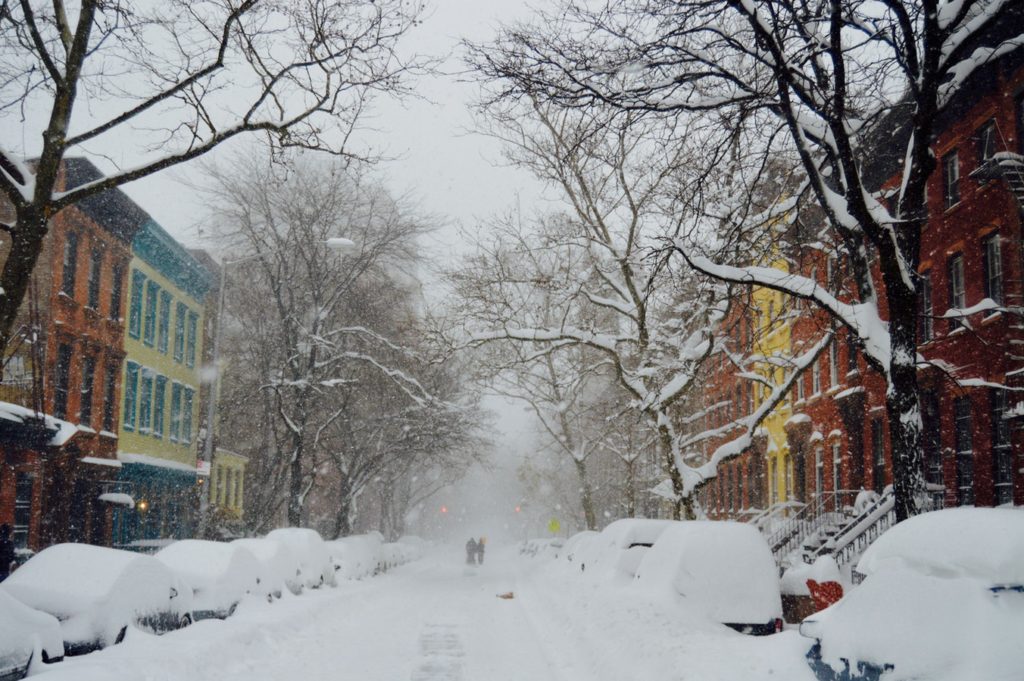
While you walk on an icy New York sidewalk, it’s easy to focus on the ground and forget to look up. But winter can leave dangers everywhere, and roofs are at risk of collapse as snow piles up on top of them. When a roof collapses, people can be seriously injured or killed, and it can cause extensive property damage—not just to the building, but to anything inside.
Causes of Roof Collapse
Although ceilings can collapse for a number of structural reasons, in the winter, the biggest danger is the weight caused by the buildup of snow, ice, or melted water if there’s a thaw. Flat roofs are particularly in danger, since the level surface makes it easier for snow to stay on top of the roof rather than sliding off. When the gutters and drains of a building become blocked, water from rain or melting snow can’t escape the roof and the buildup becomes worse. Older buildings are particularly in danger after decades of harsh weather.
Snow falls, gets warmed slightly during the day, and melts somewhat, only for cold temperatures overnight to freeze it. As this happens over and over again with additional snowfall, ice can build up on a roof. While fluffy snow might not seem like a big danger, keep in mind that a single shovelful of dense snow can weigh up to 50 pounds. A 10×10-foot area of roof can amass up to 2,000 pounds of snow and ice, even at only four or five inches of thickness.
Ways to Avoid a Snow-Related Collapse
A roof collapse can be avoided in a pretty simple way: by avoiding the buildup of snow and ice. One of the best ways to do this is to ensure the gutters and drains remain clear so melted snow and ice can drain away. Large amounts of snow can also be cleared using rakes or shovels—and when dealt with promptly, this can be done by building owners themselves at little cost.
Larger projects may require hiring a company to come out and clear snow and ice off before the weight builds up to dangerous levels. This can be expensive, especially if needed multiple times a month during serious storms, but it is much cheaper than a collapsed roof. Large icicles should also be cleared from roofs and gutters to ensure they do not drop off and injure someone.
Who Is to Blame?
When snow or ice causes a ceiling to collapse, some people might throw their hands in the air and blame Mother Nature. However, people play a role in these kinds of situations. In particular, property owners have a responsibility to provide reasonable safety to anyone who legally enters or rents their premises.
If a property owner is notified about snow or ice amassing on the roof, and the owner fails to take any kind of reasonable action, then he or she has contributed to the situation. If that ice causes the roof to collapse, it could be argued the property owner is at fault since he or she had a chance to prevent the incident. This is a form of negligence, which may make the property owner liable for the victim’s injuries and property loss.
Filing a Lawsuit in NYC
If a roof collapse occurs on private property, then the landlord may be liable for what happened—especially if it can be shown the collapse was avoidable. In some cases, renters might assume responsibility based on the terms of a rental agreement, or liability might be shared between a renter and the property owner.
On public property, NYC or the State can be held liable if it can be shown that reasonable steps were not taken to keep people safe. Anyone injured on public property must file a Notice of Claim with the Attorney General within a short period of time after the accident.
It’s important to have a top New York premises liability lawyer to handle your claim, because property owners have powerful connections—and large insurance policies. For a free consultation with the legal team at Wingate, Russotti, Shapiro, Moses & Halperin, LLP, please call (212) 986-7353.